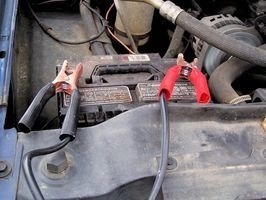How To Troubleshoot A Neutral Safety Switch

Very few things are more frustrating than a car that won't start. Frustration may be compounded if the car was running fine when it was parked. Now, though, when it is time to go, turning the key to crank the car produces nothing, and jumping the car with booster cables doesn't work. The problem could be a defective neutral safety switch.
Instructions
1.Raise the hood of the car and test the battery voltage. It should read 12.6-volts. If the battery voltage is very low, 4 or 6 volts, using jumper cables to start the car will not work. Replace the battery. If the battery voltage is OK, probe the battery positive cable at the starter with a test light. The light should brightly illuminate. If not, clean the positive battery cable at the battery and check the cable for breaks.
2.Clip the test light to the battery positive cable. Probe the negative cable where it connects to the engine or touch engine metal. The light should brightly illuminate. If not, clean the negative cable connection at the battery and check the ground cable for breaks.
3.Try to start the car and check the voltage at the starter relay wire, which is on the starter. Use a test light and probe the connection on the starter solenoid while an assistant turns the key to crank. The light should illuminate brightly as voltage is supplied to energize the starter solenoid. If not, have the assistant shift the car out of park and into neutral. If the car starts, the safety switch is defective in the park position. If the car fails to start in either position, the ignition switch is defective.
4.Set the parking brake and operate the shift selector lever slightly up and down in neutral and in park while trying to start the car. If it starts just above or blow these positions, the switch is defective or out of adjustment. It is best to replace the switch.
Instructions
1.Raise the hood of the car and test the battery voltage. It should read 12.6-volts. If the battery voltage is very low, 4 or 6 volts, using jumper cables to start the car will not work. Replace the battery. If the battery voltage is OK, probe the battery positive cable at the starter with a test light. The light should brightly illuminate. If not, clean the positive battery cable at the battery and check the cable for breaks.
2.Clip the test light to the battery positive cable. Probe the negative cable where it connects to the engine or touch engine metal. The light should brightly illuminate. If not, clean the negative cable connection at the battery and check the ground cable for breaks.
3.Try to start the car and check the voltage at the starter relay wire, which is on the starter. Use a test light and probe the connection on the starter solenoid while an assistant turns the key to crank. The light should illuminate brightly as voltage is supplied to energize the starter solenoid. If not, have the assistant shift the car out of park and into neutral. If the car starts, the safety switch is defective in the park position. If the car fails to start in either position, the ignition switch is defective.
4.Set the parking brake and operate the shift selector lever slightly up and down in neutral and in park while trying to start the car. If it starts just above or blow these positions, the switch is defective or out of adjustment. It is best to replace the switch.
- jhde5422247e8bf65deba546c18311221f.jpg